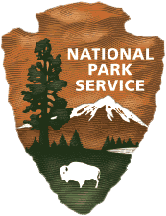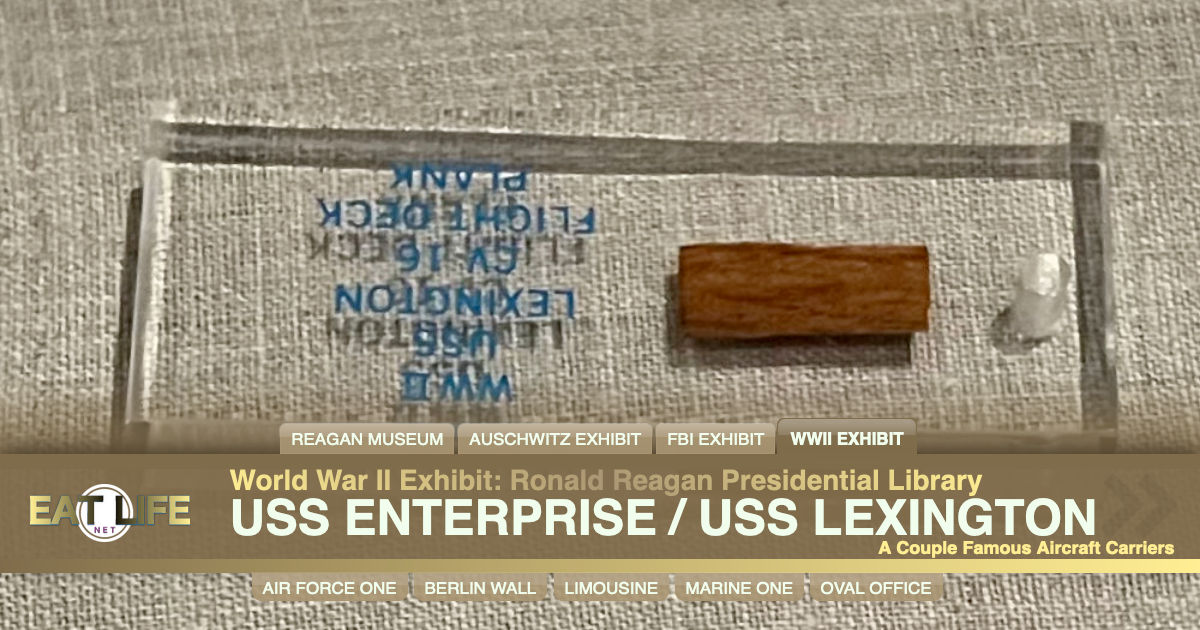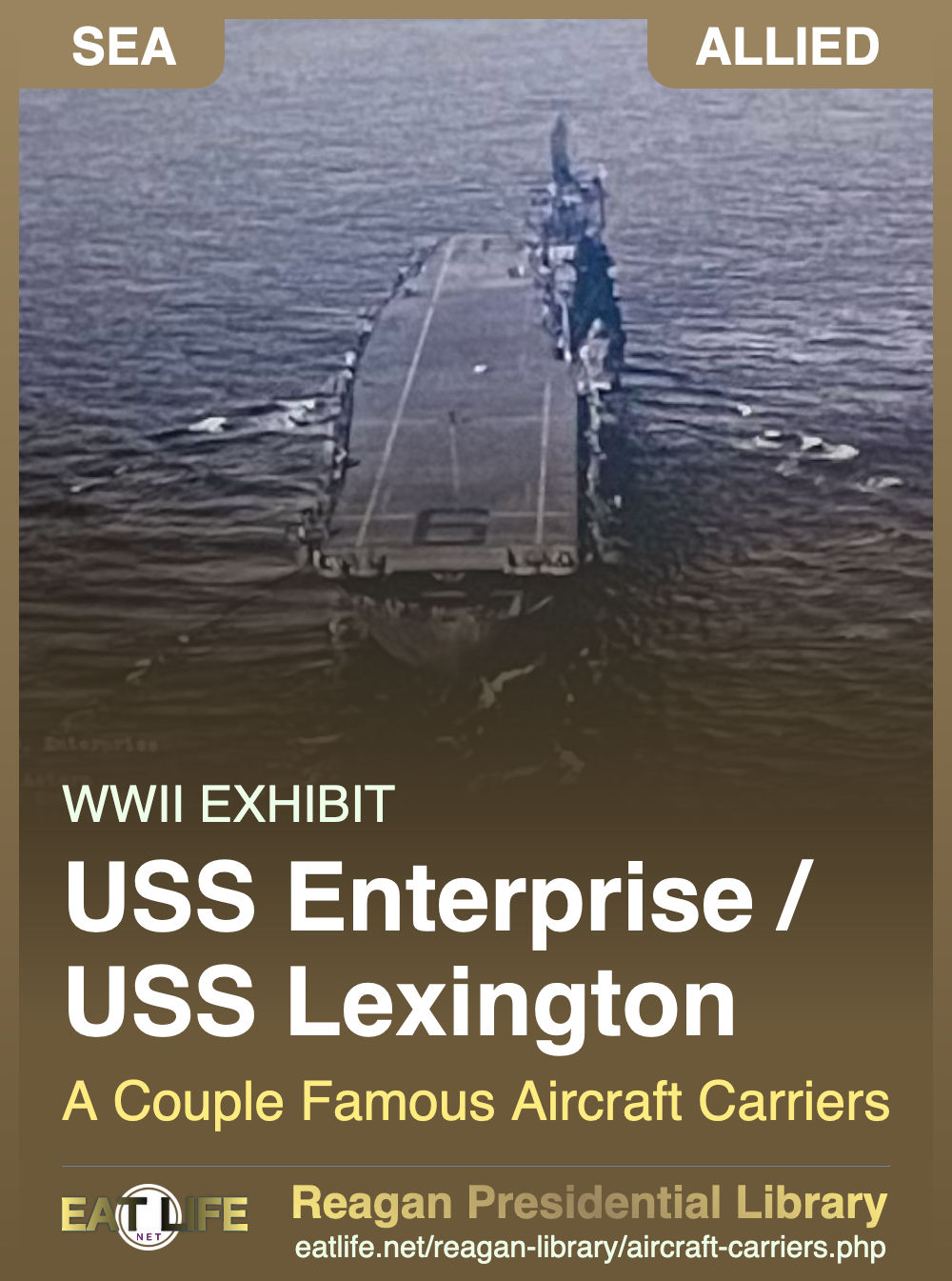- The USS Enterprise (CV-6) was the most decorated U.S. ship of World War II. The show Star Trek named the Starship Enterprise after her. Enterprise Rent-A-Car founder had served on the Enterprise as a fighter pilot.
- The USS Lexington (CV-16) participated in almost every major World War II naval campaign in the Pacific from 1943 to 1945. It had a service life longer than any other Essex-class ship.
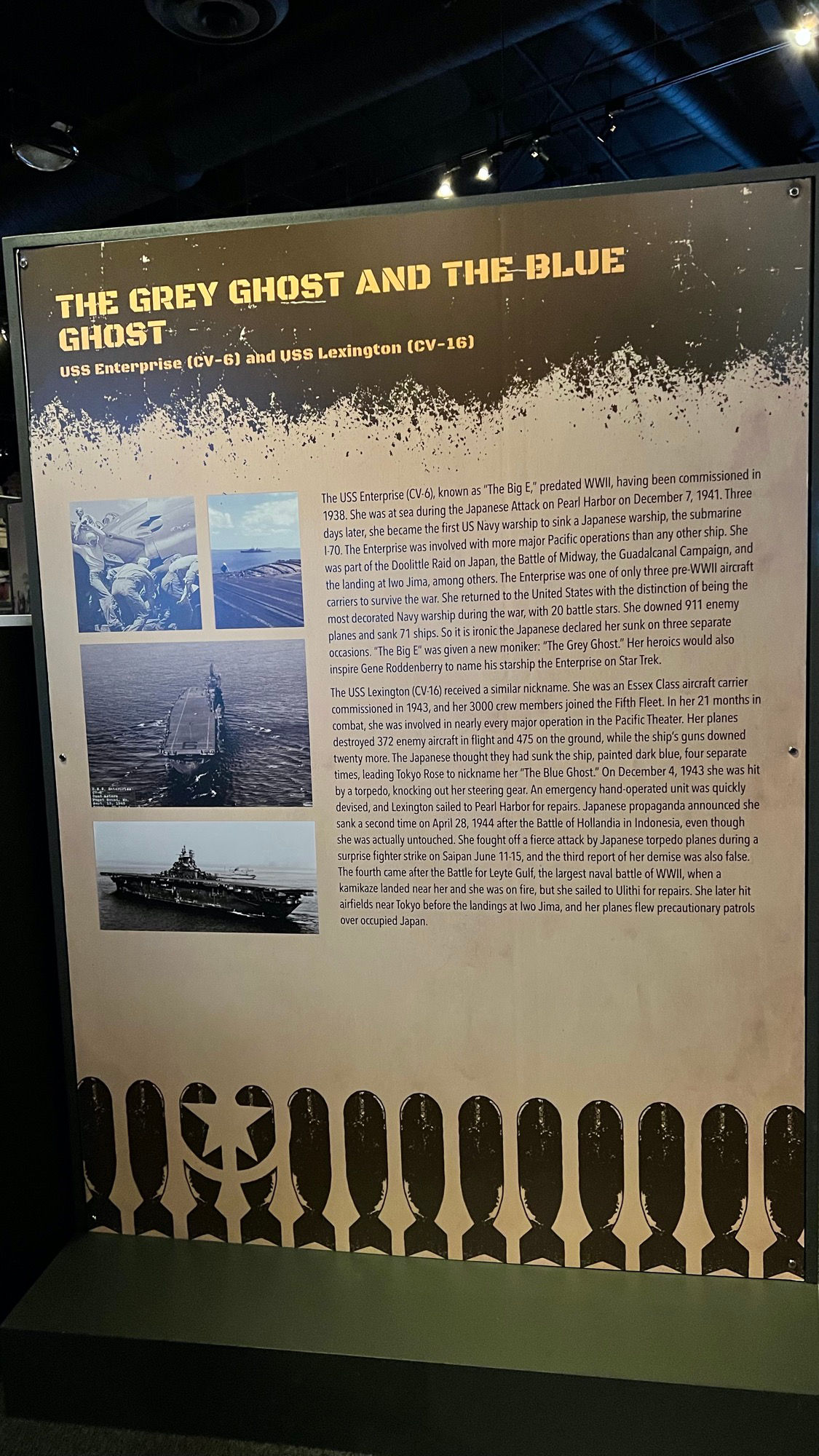
USS Enterprise (CV-6) and USS Lexington (CV-16)
The USS Enterprise (CV-6)
Known as "The Big E," predated WWII, having been commissioned in 1938.
- She was at sea during the Japanese Attack on Pearl Harbor on December 7, 1941.
- Three days later, she became the first US Navy warship to sink a Japanese warship, the submarine I-70.
- The Enterprise was involved with more major Pacific operations than any other ship.
- She was part of the Doolittle Raid on Japan, the Battle of Midway, the Guadalcanal Campaign, and the landing at Iwo Jima, among others.
- The Enterprise was one of only three pre-WWII aircraft carriers to survive the war.
- She returned to the United States with the distinction of being the most decorated Navy warship during the war, with 20 battle stars.
- She downed 911 enemy planes and sank 71 ships.
- So it is ironic the Japanese declared her sunk on three separate occasions.
- "The Big E" was given a new moniker: "The Grey Ghost."
- Her heroics would also inspire Gene Roddenberry to name his starship the Enterprise on Star Trek.
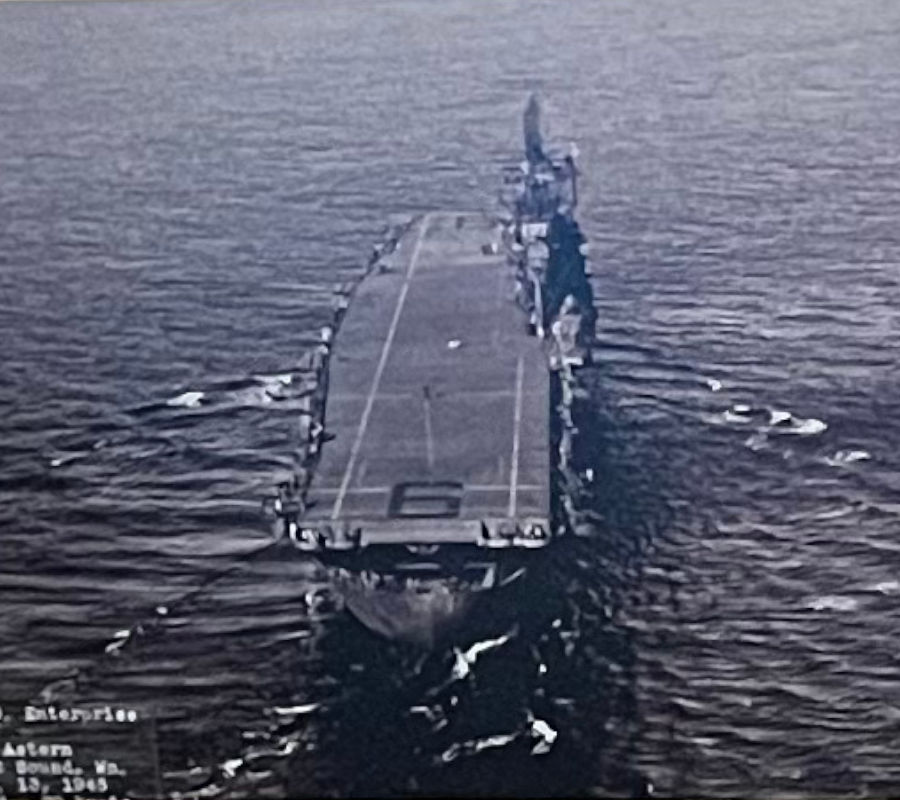 The USS Lexington (CV-16)
The USS Lexington (CV-16)
Received a similar nickname. She was an Essex Class aircraft carrier commissioned in 1943, and her 3000 crew members joined the Fifth Fleet.
- In her 21 months in combat, she was involved in nearly every major operation in the Pacific Theater.
- Her planes destroyed 372 enemy aircraft in flight and 475 on the ground, while the ship's guns downed twenty more.
- The Japanese thought they had sunk the ship, painted dark blue, four separate times, leading Tokyo Rose to nickname her "The Blue Ghost."
- On December 4, 1943 she was hit by a torpedo, knocking out her steering gear. An emergency hand-operated unit was quickly devised, and Lexington sailed to Pearl Harbor for repairs.
- Japanese propaganda announced she sank a second time on April 28, 1944 after the Battle of Hollandia in Indonesia, even though she was actually untouched.
- She fought off a fierce attack by Japanese torpedo planes during a surprise fighter strike on Saipan June 11-15, and the third report of her demise was also false.
- The fourth came after the Battle for Leyte Gulf, the largest naval battle of WWII, when a kamikaze landed near her and she was on fire, but she sailed to Ulithi for repairs.
- She later hit airfields near Tokyo before the landings at Iwo Jima, and her planes flew precautionary patrols over occupied Japan.
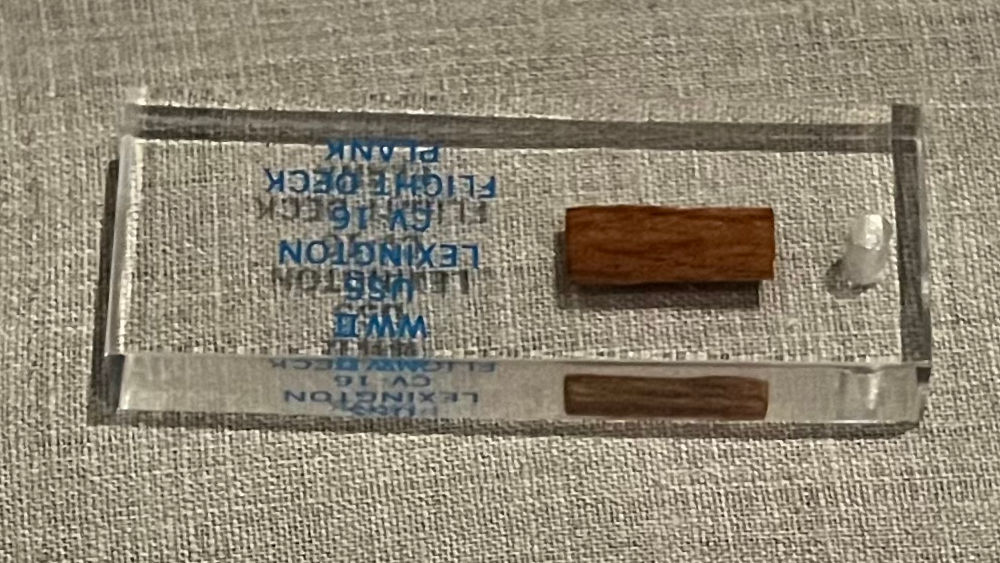
USS Lexington
WIKIPEDIAUSS Enterprise (CV-6)
Was a Yorktown-class carrier built for the United States Navy during the 1930s. It was the most decorated U.S. ship of World War II.
- She was the seventh U.S. Navy vessel of that name.
- Colloquially called "The Big E"
- The sixth aircraft carrier of the United States Navy
- Launched in 1936
- One of only three American carriers commissioned before World War II to survive the war (the others being Saratoga and Ranger)
- Participated in more major actions of the war against Japan than any other United States ship. These actions included
- The attack on Pearl Harbor - 18 Douglas SBD Dauntless dive bombers of her air group arrived over the harbor during the attack; seven were shot down with eight airmen killed and two wounded, making her the only American aircraft carrier with men at Pearl Harbor during the attack and the first to sustain casualties during the Pacific War
- The Battle of Midway
- The Battle of the Eastern Solomons
- The Battle of the Santa Cruz Islands
- Air-sea engagements during the Guadalcanal Campaign
- The Battle of the Philippine Sea
- The Battle of Leyte Gulf
- Enterprise earned 20 battle stars, the most for any U.S. warship in World War II
- The most decorated U.S. ship of World War II
- The first American ship to sink a full-sized enemy warship after the Pacific War had been declared when her aircraft sank the Japanese submarine I-70 on 10 December 1941.
- On three occasions during the war, the Japanese announced that she had been sunk in battle, inspiring her nickname "The Grey Ghost"
- By the end of the war, her planes and guns had downed 911 enemy planes, sunk 71 ships, and damaged or destroyed 192 more.
Despite efforts made by the public after the war to turn Enterprise into a museum ship, Enterprise was ultimately scrapped from 1958 to 1960.
Legacy
- Star Trek
Gene Roddenberry, creator of the television show, Star Trek, named the fictional Starship Enterprise in honor of CV-6 early on in the development of the show, because he was "particularly fascinated" by her war record, and had "always considered it a heroic ship".- Enterprise Rent-A-Car
Jack C. Taylor, founder of Enterprise Rent-A-Car, had served on Enterprise as a fighter pilot during the war, and (re-)named his company in 1969 after the ship.
National Park ServiceUSS Lexington (CV-16)
Launched in 1942 as a welded, steel hull, Essex-class aircraft carrier with an overall length of 872 feet and a length along the waterline of 820 feet. Lexington had hangar deck capacity for 103 aircraft. Lexington's first air group (AG-16), consisted of 89 aircraft that included 32 F6f-3 Hellcat fighters, 35 SBD-5 Dauntless dive-bombers and 18 TBF-1 Avenger torpedo bombers.The aircraft carrier USS Lexington (CV-16) participated in almost every major World War II naval campaign in the Pacific from 1943 to 1945. The ship was a highly decorated warship, receiving numerous citations acknowledging her exemplary service. As an Essex-class carrier, Lexington is also important for illustrating the development of aircraft carrier design, the refinement of multi-carrier operations, and the integration of aviation as a primary strike weapon in naval strategy.
On November 26, 1991 Lexington was decommissioned. After making the successful bid to preserve, display and interpret Lexington, the city of Corpus Christi, Texas prepared a new life for the carrier as a museum ship.
Although naval aviation was utilized during World War I, aircraft assigned to warships generally provided only reconnaissance support for the fleet.
The possibility of using planes as a naval strike weapon did not begin until the 1920s when aircraft capable of performing heavy bombardment against land or sea targets were built. Naval vessels capable of carrying several squadrons of such aircraft were developed concurrently. Thus the first eight carriers constructed by the U.S. Navy varied in size, speed, protection and aircraft complement in order to provide the greatest number of carriers capable of launching the greatest number of air strikes, yet still comply with treaty-imposed tonnage restrictions. A total of 26 Essex-class carriers were ordered by the U.S. Navy between February 1940 and June 1943 and 24 were completed. This was the largest class of carriers ever built by the United States and over half, including Lexington (CV-16), served as part of the Pacific Fleet during World War II.
Prior to World War II, the Navy had no practical battle experience for its carriers. It was in the Pacific Theater that aircraft carrier operations were developed and refined. Serving as mobile air bases, carriers could maneuver aircraft around the open waters and scattered island chains of the Pacific. By employing a combination of scouting, fighter or bomber aircraft to control the enemy's air power, groups of carriers, screened by surface ships, could open the way for island invasions, cover and support amphibious operations, and help to hold the conquered areas. Thus carriers became an integral compound of nearly every campaign throughout the Pacific War. With aircraft that extended the fleet's firepower beyond the range of large caliber battleship guns, the carrier's status was elevated from reconnaissance platform to that of major surface combatant.
World War II and the carrier campaigns of the Pacific firmly established the role of aviation within naval operations and the aircraft carrier replaced the battleship as the Navy's primary strike weapon. With postwar advances in nuclear arms and jet propulsion, the Essex carriers were upgraded to facilitate these new weapons and aircraft. Thus with modifications, Lexington continued to serve through the Cold War where air power played an increasingly important role in the major wars and limited engagements of the period.
WIKIPEDIAUSS Lexington
CV-16, CVA-16, CVS-16, CVT-16, AVT-16
Essex-class aircraft carrier built during World War II for the United States Navy. Originally intended to be named Cabot, the new aircraft carrier was renamed while under construction to commemorate the recently-lost USS Lexington (CV-2), becoming the sixth U.S. Navy ship to bear the name in honor of the Battle of Lexington.Lexington was commissioned in February 1943 and saw extensive service through the Pacific War.
- For much of her service, she acted as the flagship for Admiral Marc Mitscher, and led the Fast Carrier Task Force through their battles across the Pacific.
- She was the recipient of 11 battle stars and the Presidential Unit Citation.
- Following the war, Lexington was decommissioned, but was modernized and reactivated in the early 1950s, being reclassified as an attack carrier (CVA). Later, she was reclassified as an antisubmarine carrier (CVS).
- In her second career, she operated both in the Atlantic/Mediterranean and the Pacific, but spent most of her time, nearly 30 years, in Pensacola, Florida, as a training carrier (CVT).
Lexington was decommissioned in 1991, with an active service life longer than any other Essex-class ship. Following her decommissioning, she was donated for use as a museum ship in Corpus Christi, Texas. In 2003, Lexington was designated a National Historic Landmark. Though her surviving sister ships Yorktown, Intrepid, and Hornet carry lower hull numbers, Lexington was laid down and commissioned earlier, making Lexington the oldest remaining fleet carrier in the world.



